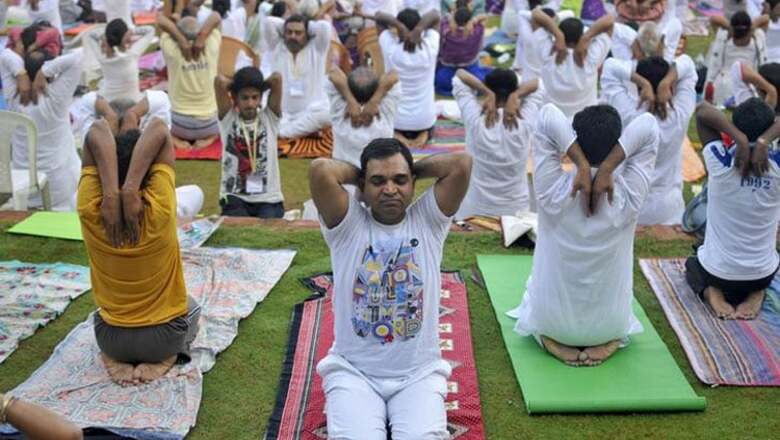
views
As over 200 million people gather to participate in events across the world to mark the inaugural International Yoga Day, here is a list of Yoga asanas that are most widely practised.
Mantra Yoga
Mantras (or mantrams) are words, phrases, or syllables which are chanted thoughtfully and with growing attention. Mantra yoga meditation involves chanting a word or phrase until the mind and emotions are transcended and the super conscious is clearly revealed and experienced. Since the mind wanders often, the rhythm of the mantra easily rescues the mind and brings it back to the object of one’s meditation.
Hatha Yoga
In Sanskrit, HA means sun, THA means moon. Hatha Yoga is widely and is the most common and the most widely accepted form of Yoga. Yoga practitioners claim that haath yoga gives them a chance to become extremely clear-minded and can concentrate well. Hatha yoga is also practiced as a main method for spiritual realization.
Kundalini Yoga
Kundalini literally means "coiled" and is represented by a metaphorical coiled snake at the base of your spine. Relatively new to the Western Hemisphere, Kundalini, "the yoga of awareness," builds strength and releases the energy located at the base of the spine. Kundalini yoga focuses on breath and movement. It further challenges its practitioners both physically and mentally. It is one of the oldest forms of yoga – it has been practiced by the Upanishads in India since 500 BC.
Mastering the practice at sixteen, Yogi Bhajan brought Kundalini to the West in 1969. Initially, it was never taught publicly until Bhajan challenged its secrecy and taught Kundalini openly to the public and consequently established the 3HO, which stands for "Healthy, Happy, Holy Organization."
Bhakti Yoga
Bhakti yoga, or devotional yoga, is the most natural path for those who are dominantly seeking emotional fulfillment and well being. The "bhakta" devotee usually practices meditation by visualizing, thinking and feeling the divine presence around him. The bhakta shares his deepest thoughts and concerns with the Lord until a continual flow of awareness moves between devotee and his or her beloved Lord.
Karma Yoga
Karma means 'to do.' Karma refers to the universal principle of cause and effect. For every effect there’s a cause, and the devotee realizes that he, in his present life situation, is experiencing the effects owing to a number of causes which are actioned and enacted. He recognizes that for a finer, more fulfilling life he has to change his thoughts and feelings and so express himself through his actions in such a manner,that new causes supplant old habits and attitudes.
Jnana Yoga
Jnana means wisdom or discernment. Jnana yoga is thus the path of wisdom and jnana meditation is many-faceted. The main purpose of jnana meditation is to withdraw the mind and emotions from perceiving life with a myopic view and to behold and live with Reality, or Spirit. One principal way that the "jnani," the yogi of discernment, meditates is to patiently release or put aside all thoughts and feelings and heart and is allowed to do a work on transformation and enlightenment within the rapt meditator.
Raja Yoga
Raja means royal or kingly. Raja yoga meditation is generally based on directing one’s life force to bring the mind and emotions into balance. This is done to ensure that the attention may be easily focused on the object of meditation, or the Lord directly. The meditation point, which is about half an inch above the point where the eyebrows meet, is called ajna, or the third eye.
Tantra Yoga
The word tantra literally means "expansion." A tantra yogi concentrates on expanding all levels of his or her consciousness to unveil and realize the Supreme Reality. Tantra focuses on the dynamic aspect of divinity called Shakti, or "the Cosmic Mother." The tantric devotee strives to attune with the spiritual dynamic energy in order to transform personal limitations and release subconscious blockages.


















Comments
0 comment